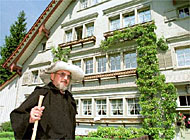Following in the footsteps of pilgrims

There's been an impressive revival in interest in pilgrimage trails through Switzerland, and today visitors can literally walk across the entire country in the footsteps of Christian pilgrims.
They made the long journey to worship at the tomb of St James in Santiago de Compostela in Spain.
Christians trekked across Switzerland on the St James pilgrimage for well over 1,000 years. The routes sretch from Constance and Rorschach on Lake Constance in the far northwest right across the country to Geneva in the extreme southeast.
Their ultimate destination was the tomb of St James on Spain’s northwest coast. In the Middle Ages, it was the most visited Christian site after Rome and Jerusalem. In the bible, the book of Matthew tells how Jesus was walking by the Sea of Galilee, when he saw a “pair of brothers, James son of Zebedee and his brother John; they were in the boat with their father Zebedee, overhauling their nets. He called them and at once they left their boat and the father, and followed him.”
Since James the Apostle became a saint, Christians have been flocking to his tomb in Santiago de Compostela. The pilgrimage is of interest even to non-Christians because it spawned traditions that persist to this day.
In the Middle Ages, souvenir-hungry pilgrims would gather shells on the beach at Santiago, so they could continue to hear the sound of the sea once they had returned home. The shells soon acquired a special significance, coming as they did from the resting-place of St James. Among devout Christians a tradition spread of wearing a shell over one’s heart. It is thanks to this practice that shirts and jackets always have a breast pocket on the left side, covering the heart.
Pilgrims also made vast detours to pass through Switzerland, attracted by many important Christian sites scattered throughout the country. Today, the Swiss routes are clearly marked with brown signs so visitors can follow the original “Jakobsweg”. From Lake Constance, pilgrims would walk to Fischingen in canton Thurgau, where the Iddachapel is a special pilgrims’ destination. Its namesake, St Idda, was expelled from her castle home by her husband and then lived as a hermit. A hole on her grave, in the shape of a footprint, is said to cure aching feet.
The trail winds it way down to the Lake of Zurich, where pilgrims would water their animals, and continues to Einsiedeln in canton Schwyz. The town became an important place of pilgrimage during the Middle Ages, when devouts would come to worship before a wooden statue of the madonna.
After centuries in the local church, the statue became blackened by soot, dust and smoke. Then came the French revolution and the monks were forced to flee to Italy and later Austria. They carried her with them into exile, and at some point on the journey decided to clean her up. However, so ingrained was the smoke and dirt that they decided it would better to blacken her. When Napolean allowed them to return, the black madonna was restored to her rightful place in the church, where she stands today.
The madonna has largely usurped the place of another icon of Einsiedeln, the hermit saint, Meinrad. He was a Benedictine monk, who gave the town its name – Einsiedeln is a corruption of “ein Siedler” (one settler). By all accounts he was a kindly fellow, who settled in the area in the ninth century. He lived there for 26 years, until he was murdered by two mercenary travellers. (They were later tried and executed in Zurich.)
A chapel was erected in Meinrad’s honour, and is today located in the middle of the town’s cathedral, one of Switzerland’s most impressive churches.
From Einsiedeln, the pilgrims trekked to Lake Lucerne, and then to Sachseln, home of St Niklaus (von Flüe). Born in 1417, this remarkable character was given leave by his long-suffering wife to live for 50 years as hermit. After siring 10 children, he took up residence not 500 metres from the family farmhouse, and spent the rest of his days doing good for the general public. Whether his solitary life damaged or improved his marriage is not recorded. He was declared a saint in 1947.
Continuing along the pilgrim trail one comes to the lakes of Brienz and Thun in the Bernese Oberland. These magnificent bodies of water lie in a valley dominated by the towering peaks of the Eiger, Mönch and Jungfrau.
One of most impressive sites here is the Beatus caves on the northern shore of lake Thun. These were home to the English missionary, Beatus, and became famous in the 15th century. Pilgrimages were organised to the chapel in times of misfortune. It was destroyed during the Reformation, but the caves are well worth a visit.
Modern-day pilgrims who want to see a pictorial image of St James could do worse than follow the trail through the town of Fribourg. Here is the Cathedral of St Nicolas with five scenes depicting James himself. The town is also home to the hospital of St James.
The trail ends in Geneva, where the pilgrims would have rested before moving on into France. The stained glass windows in St Peter’s Cathedral show James dressed in a royal red coat with ermine borders. No doubt the former fisherman and apostle – who was as poor as the proverbial churchmouse – would have been amused to see himself so attired.
by Jonas Hughes

In compliance with the JTI standards
More: SWI swissinfo.ch certified by the Journalism Trust Initiative
You can find an overview of ongoing debates with our journalists here. Please join us!
If you want to start a conversation about a topic raised in this article or want to report factual errors, email us at english@swissinfo.ch.